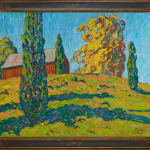Allen Tucker 1866-1939
October Shadows, c. 1918
Oil on canvas
40 x 50 inches
101.6 x 127 cm
Framed dimensions 48 x 58 inches
101.6 x 127 cm
Framed dimensions 48 x 58 inches
Signed lower right: Allen Tucker
Exposure to the latest artistic currents at the 1913 Armory Show had a profound effect on Allen Tucker's own artistic development, prompting him to move away from impressionism to a...
Exposure to the latest artistic currents at the 1913 Armory Show had a profound effect on Allen Tucker's own artistic development, prompting him to move away from impressionism to a more subjective manner inspired by Post-Impressionism, especially the art of Vincent van Gogh. Tucker subsequently became one of the first American painters to experiment with pure color, spirited brushwork, and a heavily encrusted paint surface, prompting critics to dub him the "Van Gogh of America."1
A landscape specialist, Tucker's greatest delight was in painting the countryside of Maine and Massachusetts, the sea and coast of the East, and the Highlands of New Jersey. He was also drawn to scenes in France and Italy. As was the case with van Gogh, Tucker sought themes of solitude and isolation, favoring robust expanses of meadowland and mountain scenery, as well as inland forests. October Shadows, presenting nature as a formidable power, relegates human presence to a rustic barn partially shielded by trees. While figures have been eliminated, Tucker creates human-like forms within the swaying shrubbery and large, animated trees. Both Tucker and van Gogh viewed trees as symbols of growth and renewal, and accordingly, portrayed them as dynamic, upward- shooting forms. He energizes his composition through bold juxtapositions of contrasting forms−foreground to background, dark to light−that have a dynamism drawn from his brushwork.
October Shadows is related to a painting titled Red Barns, 1923, in The Phillips Collection in Washington, District of Columbia.
1 See, for example, James W. Lane, "Vincent in America: Allen Tucker," Art News, Vol. 38, December, 1939, pages 171-178.
A landscape specialist, Tucker's greatest delight was in painting the countryside of Maine and Massachusetts, the sea and coast of the East, and the Highlands of New Jersey. He was also drawn to scenes in France and Italy. As was the case with van Gogh, Tucker sought themes of solitude and isolation, favoring robust expanses of meadowland and mountain scenery, as well as inland forests. October Shadows, presenting nature as a formidable power, relegates human presence to a rustic barn partially shielded by trees. While figures have been eliminated, Tucker creates human-like forms within the swaying shrubbery and large, animated trees. Both Tucker and van Gogh viewed trees as symbols of growth and renewal, and accordingly, portrayed them as dynamic, upward- shooting forms. He energizes his composition through bold juxtapositions of contrasting forms−foreground to background, dark to light−that have a dynamism drawn from his brushwork.
October Shadows is related to a painting titled Red Barns, 1923, in The Phillips Collection in Washington, District of Columbia.
1 See, for example, James W. Lane, "Vincent in America: Allen Tucker," Art News, Vol. 38, December, 1939, pages 171-178.
Provenance
Estate of the artist;Mrs. Allen Tucker, New York;
The Allen Tucker Memorial, New York;
Milch Galleries, New York, 1946;
Private collection;
Mr. & Mrs. S. Gamerov, Lawrence, New York, 1986;
D. Wigmore Fine Art, New York, 1995;
Mr. & Mrs. Stephen M. Sessler, 1995;
Avery Galleries, Bryn Mawr, Pennsylvania, 2016;
Private collection, Pennsylania, until 2023
Exhibitions
Georgia Museum of Art, University of Georgia, Athens, Before 1948 - American Paintings in Georgia Collections, January 15 - March 14, 1999, no. 48.Literature
Before 1948 - American Paintings in Georgia Collections, Georgia Museum of Art, University of Georgia, Athens, 1998, p. 118, no. 48.Please join our mailing list
* denotes required fields
We will process the personal data you have supplied in accordance with our privacy policy (available on request). You can unsubscribe or change your preferences at any time by clicking the link in our emails.



